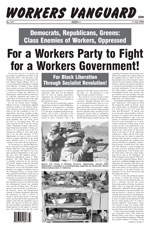
Corrections on Tibet In the article “Counterrevolutionary Riots in Tibet” (WV No. 911, 28 March), we stated, “The recent opening of the Lhasa-Qinghai railway, connecting Tibet to China, has led to economic development and an improvement of living standards” (emphasis added). This implies that Tibet is not part of China; we should have said, “connecting Tibet to the rest of China.” In the same article, we also wrote: “During the misnamed ‘Great Proletarian Cultural Revolution’ that began in the mid 1960s, in which Mao mobilized millions of student youth to buttress his position in an intra-bureaucratic factional feud, Mao subjected the Tibetans to fierce Great Han chauvinism. Tibetan language and native dress were proscribed. Much of what had been at the core of Tibetan culture was simply smashed up and destroyed, although with the beneficial side effect of driving monks into actual labor.” This passage feeds into a widespread distortion promoted by the Dalai Lama camp and the imperialists that during the Cultural Revolution Mao mobilized Han student youth to “smash up and destroy” much of what had been at the core of Tibetan culture. But it was mostly Tibetan youth who destroyed many Buddhist relics and palaces. Wang Lixiong, in his very thoughtful article, “Reflections on Tibet” (New Left Review, March-April 2002), points out: “The truth is that, because of poor transportation and the huge distances involved, only a limited number of Han Red Guards actually reached Tibet. Even if some of them did participate in pulling down the temples, their action could only have been symbolic. Hundreds of shrines were scattered in villages, pastures and on rugged mountainsides: no one would have been capable of destroying them without the participation of the local people. Furthermore, most of the Red Guards who did reach the TAR [Tibet Autonomous Region] were Tibetan students, returning from universities elsewhere.… “Surely these actions are evidence that, once they realized they could control their own fate, the Tibetan peasantry, in an unequivocally liberating gesture, cast off the spectre of the afterlife that had hung over them for so long and forcefully asserted that they would rather be men in this life than souls in the next.” The Cultural Revolution inflicted tremendous human and economic damage on Tibet, as it did everywhere in the People’s Republic of China. It was, in fact, anti-culture, including that of Han Chinese as well as Western art and music. At the same time, there was indeed Han chauvinism. The Tibetan language and native dress—as was the case with all minority nationalities—were attacked during the Cultural Revolution. In the article “Mumia Must Be Freed Now!” (WV No. 913, 25 April), we printed the speech delivered by Spartacist League speaker Reuben Samuels at the April 19 Oakland united-front protest to free Mumia Abu-Jamal, in which he stated: “The extension of the Chinese Revolution to Tibet ended slavery and the status of women as beasts of burden.” (A similar statement appeared in a speech by Paula Daniels, printed in the 9 May WV No. 914 article, “Join Us in the Fight for a Workers America!”) This is true. But it could imply that slavery was the dominant mode of production. The dominant forms of forced peasant labor (for example, ulag) in Tibet were feudal in character. Peasants were not chattel, but had to regularly provide unpaid labor to the landlords/Lamaocracy. Individual slaves existed, but this was not the basis of the economy.
|
||||||||||||
